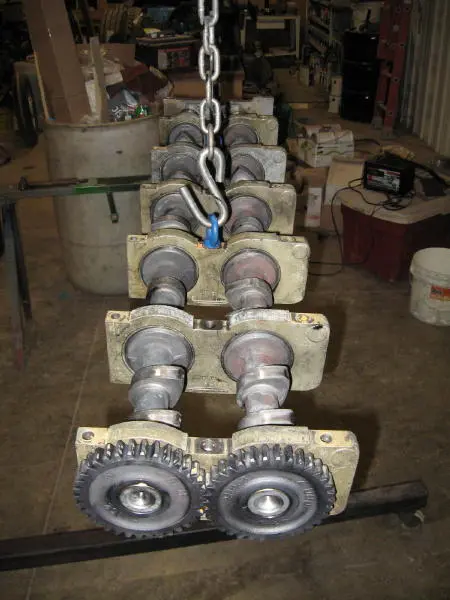
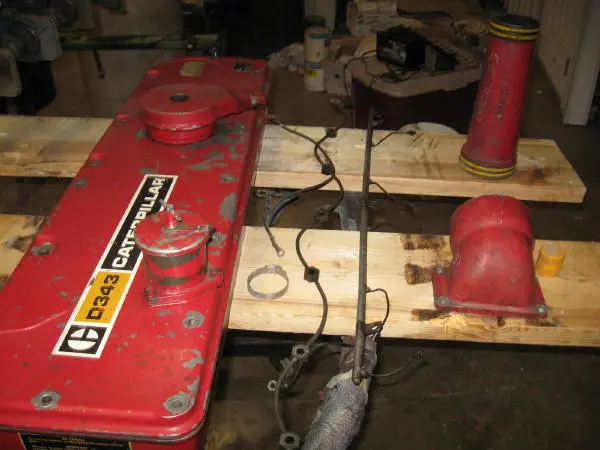
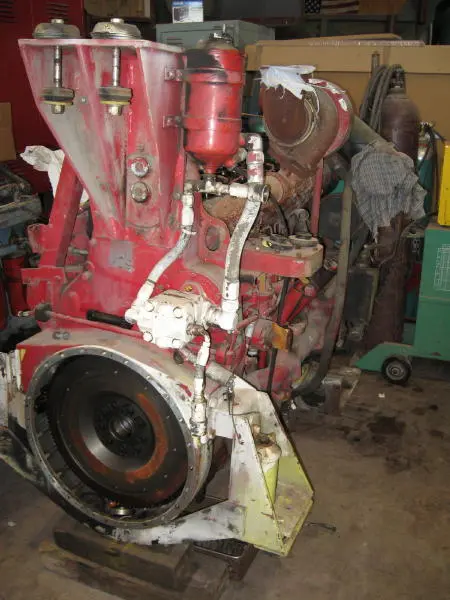
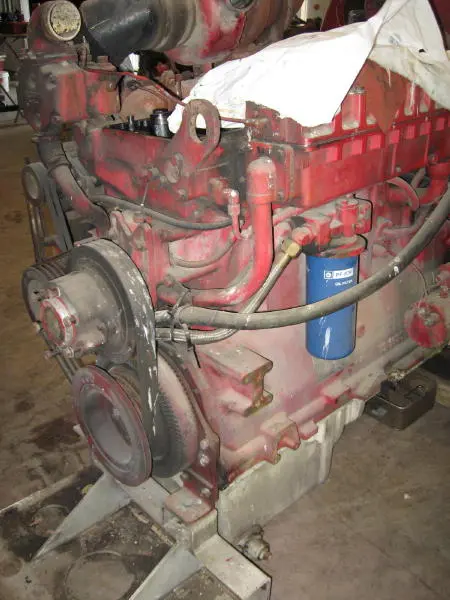
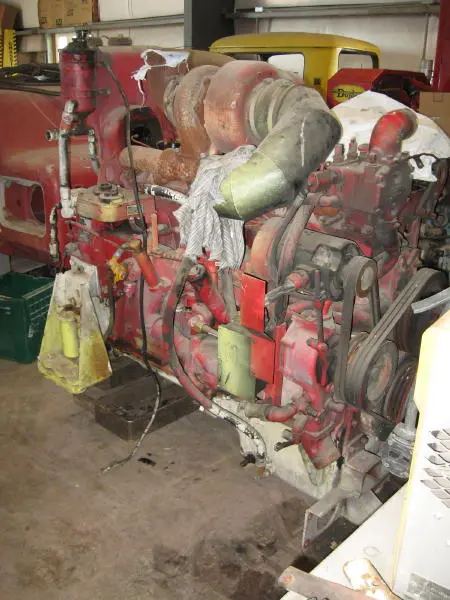
Take the side plate off the block.
Later Bob
[quote="bob"]Take the side plate off the block.
Later Bob[/quote]
Thank you for your reply Bob. After looking at the parts needing removed to take off the plate, (many) I did "fish" it out through the dipstick tube, (after removing the bolt on adapter) with a magnet. I could actually see the dowel sitting on the bottom of the pan.
Thanks,
Rob
That was good Rob. I know it's a bit of work, I have gone in that way to change a piston and liner. Just one other thing, if you have trouble getting enough valve clearance you can get some shim washers to go on those dowels and raise the cam bearing blocks. Some rebuilt heads are ground down too thin.
Later Bob
[quote="bob"]That was good Rob. I know it's a bit of work, I have gone in that way to change a piston and liner. Just one other thing, if you have trouble getting enough valve clearance you can get some shim washers to go on those dowels and raise the cam bearing blocks. Some rebuilt heads are ground down too thin.
Later Bob[/quote]
Thank you Bob, I have no experience on this engine at all. I have a 1693TA in a 1978 Mack truck, and this D343 from an Oshkosh airport crash truck. What started this ordeal was I wanted to physically see the camshafts and adjust the lash. Two bolts broke off from rusting through the shanks just rearward of the turbocharger. I had to take off all of the stuff to get the cam box housing off to get to the broken bolts. There was enough broken bolt shank sticking up to grip with a stud remover. A few easy taps after setting overnight in B'laster, and slow, steady force they both broke free and came out.
I cleaned everything up well with diesel fuel and a pump sprayer, then put it back together. I have a Cat Service manual for this series of engine which is very helpful.
Is there a tool for setting the valve lash of this engine or does one just use a #3 Phillips screwdriver? I ran all the lash adjusters to maximum clearance before breaking the cam carriers loose. That is a job in one sitting, very tiring on the wrists!
I will be sure to follow your advice on the shim washers to correct for clearance.
Thanks again,
Rob
I have a broken tappet sitting by my lathe, was going to make a better tool 30 yrs ago but it's still in the raw steel. Another thing with thin heads the bolts holding the cam box to the tining cover can hold it up and gasket not pinch enough. If that happens use two gaskets under cam box to hold it up and bolts to timing cover will line up. They are the same engine but truck engines have more aluminium parts and each engine fuel system is set up to OEM specs. Rack setting for power, Full load speed, Droop(gov spring)
Later Bob
[quote="bob"]I have a broken tappet sitting by my lathe, was going to make a better tool 30 yrs ago but it's still in the raw steel. Another thing with thin heads the bolts holding the cam box to the tining cover can hold it up and gasket not pinch enough. If that happens use two gaskets under cam box to hold it up and bolts to timing cover will line up. They are the same engine but truck engines have more aluminium parts and each engine fuel system is set up to OEM specs. Rack setting for power, Full load speed, Droop(gov spring)
Later Bob[/quote]
The D-343 engine had never been apart other than the cam cover for adjustment through it's service life. Everything bolted right back up with little effort using new gaskets everywhere it was taken apart. Physically these engines look close with the exception of the flywheel housings, and oil pans. The 1693TA has a "Brakesaver" on the back, where the D-343 does not. The 1693TA has a rear sump pan, the D-343 has a front sump. They both have SAE #1 flywheel housing size, with double the number of bolt holes for the clutch bellhousing on the D-343. Of course there are some ancillary mounting differences but nothing difficult to relocate. I drove the crash truck last year just before it exploded the transfer case, (literally) and it ran very well. A replacement case, (from Oshkosh) was over $24000,00 so the truck was not repaired, but rather replaced with a new unit at over 10 times that cost. This is how I acquired it as I work at the airport.
I plan to install it into another truck. Also need to have the pump/injectors recalibrated as it is set "up there" for Oshkosh fire service. I don't think I could fit enough radiator to cool it's 620hp intemittent rating in a standard truck, (as if I would ever need that much in a hobby truck).
Are there any tricks or benefits to running the overhead loose, tight, or timing advance different from the manuals?
Thanks,
Rob
I would just set things to standard specs Rob. I think we might have had a similar truck in our shop about 30 years ago. It was a fire truck that belonged to the Air Force and was used at the Trenton Air Base. It had lots of power and had to accelerate very quickly to reach fires fast. The torque of 600+HP takes a toll on drive lines. If you are not going to work the truck you could leave it set up as is but if you want to pull loads better adjust the rack and speeds to that of your other engine. Rack setting controls the HP and the governor spring(some times weights too) controls your "Droop" Drop from high idle to full load speed at full throttle.
Later Bob
[quote="bob"]I would just set things to standard specs Rob. I think we might have had a similar truck in our shop about 30 years ago. It was a fire truck that belonged to the Air Force and was used at the Trenton Air Base. It had lots of power and had to accelerate very quickly to reach fires fast. The torque of 600+HP takes a toll on drive lines. If you are not going to work the truck you could leave it set up as is but if you want to pull loads better adjust the rack and speeds to that of your other engine. Rack setting controls the HP and the governor spring(some times weights too) controls your "Droop" Drop from high idle to full load speed at full throttle.
Later Bob[/quote]
It is entirely possible Bob. The chassis this engine is from is an ex USAF P4 tanker with foam added. 1974 was the build year with the engine produced 12/73. It had resided at the airport for the past 20 years or so and has always been a very good unit. When it had the major malfunction a couple of years ago the cost was too great to repair. Federal grant and infrastructure support money was allocated and the unit replaced with new. I was then given the old unit as I'm into old trucks, (more than I should be)! One thing that really surprised me with this unit is that all of the driveline was supported by a 1710 series Spicer driveline. Seems a bit small for the loading it would need to endure but most of the universals seem to be original to the truck the best I can tell. The entire belly of the unit is white and does not show evidence of repaint.
I'm getting kinda anxious to install this into a road truck and it will be a hobby type of usage. Most likely I will pull the sled with it a few times at the tractor pulls as I'm not a trucker.
Thanks and I appreciate your insight!
Rob